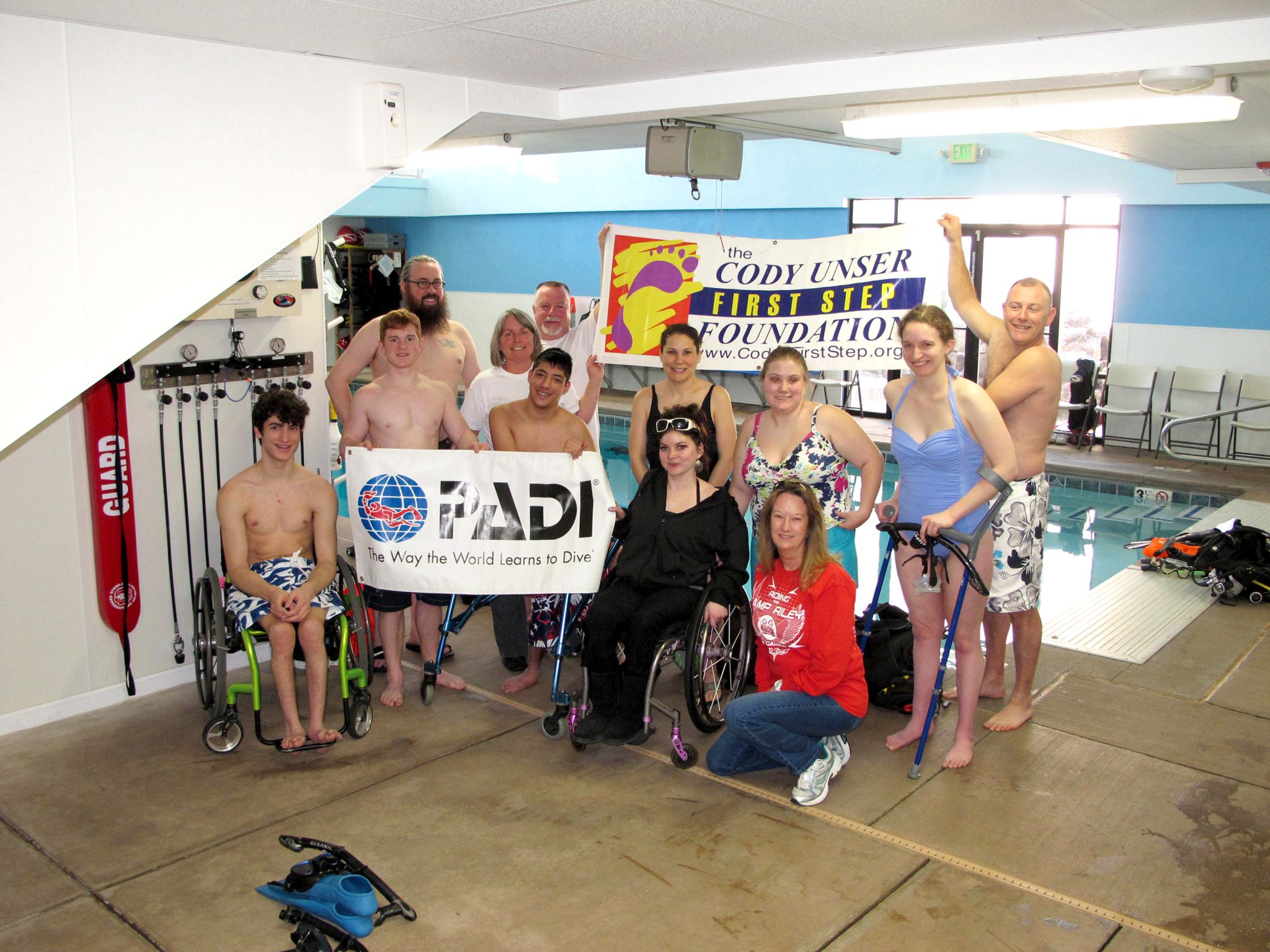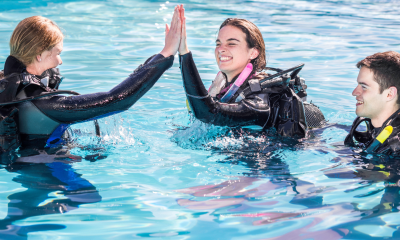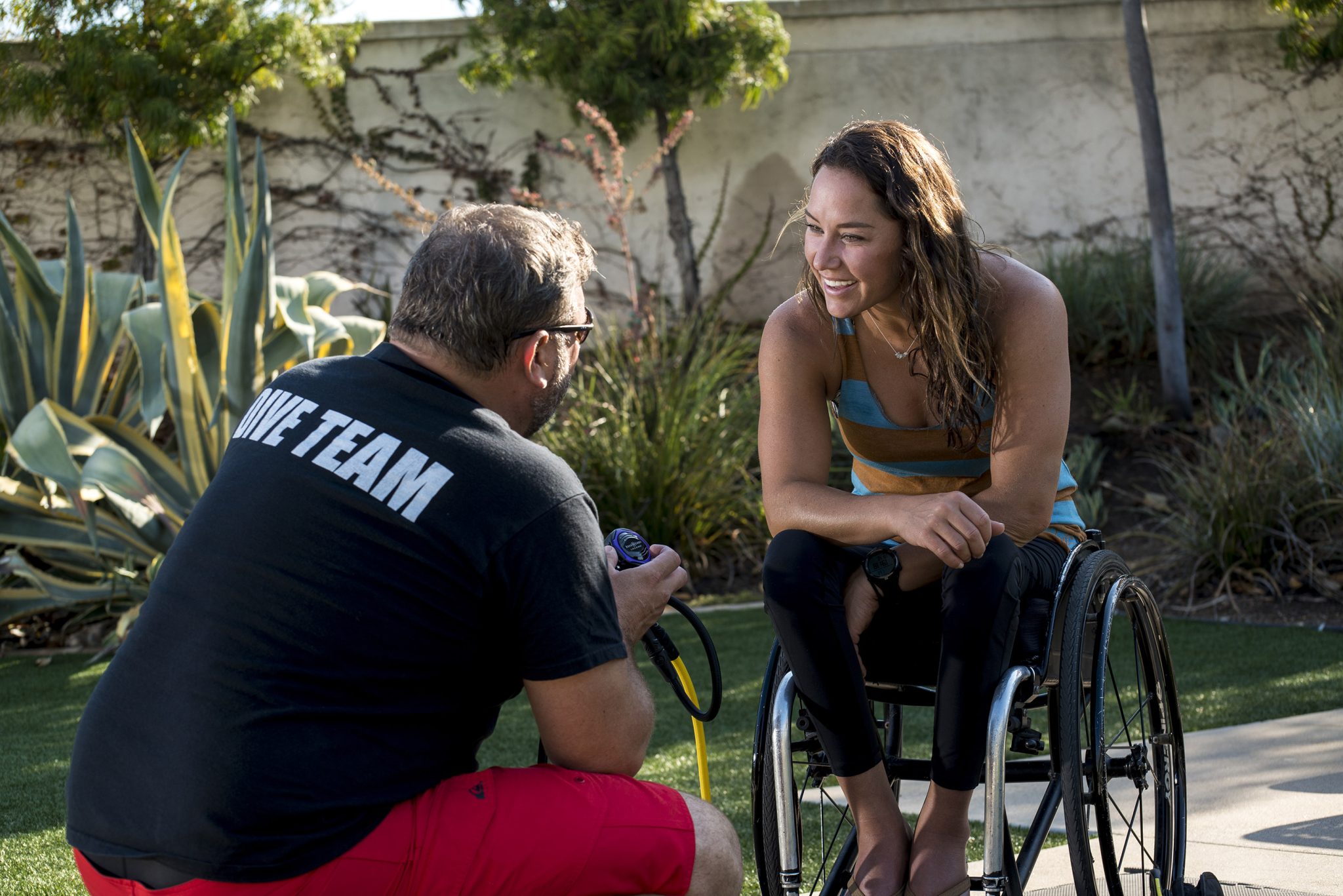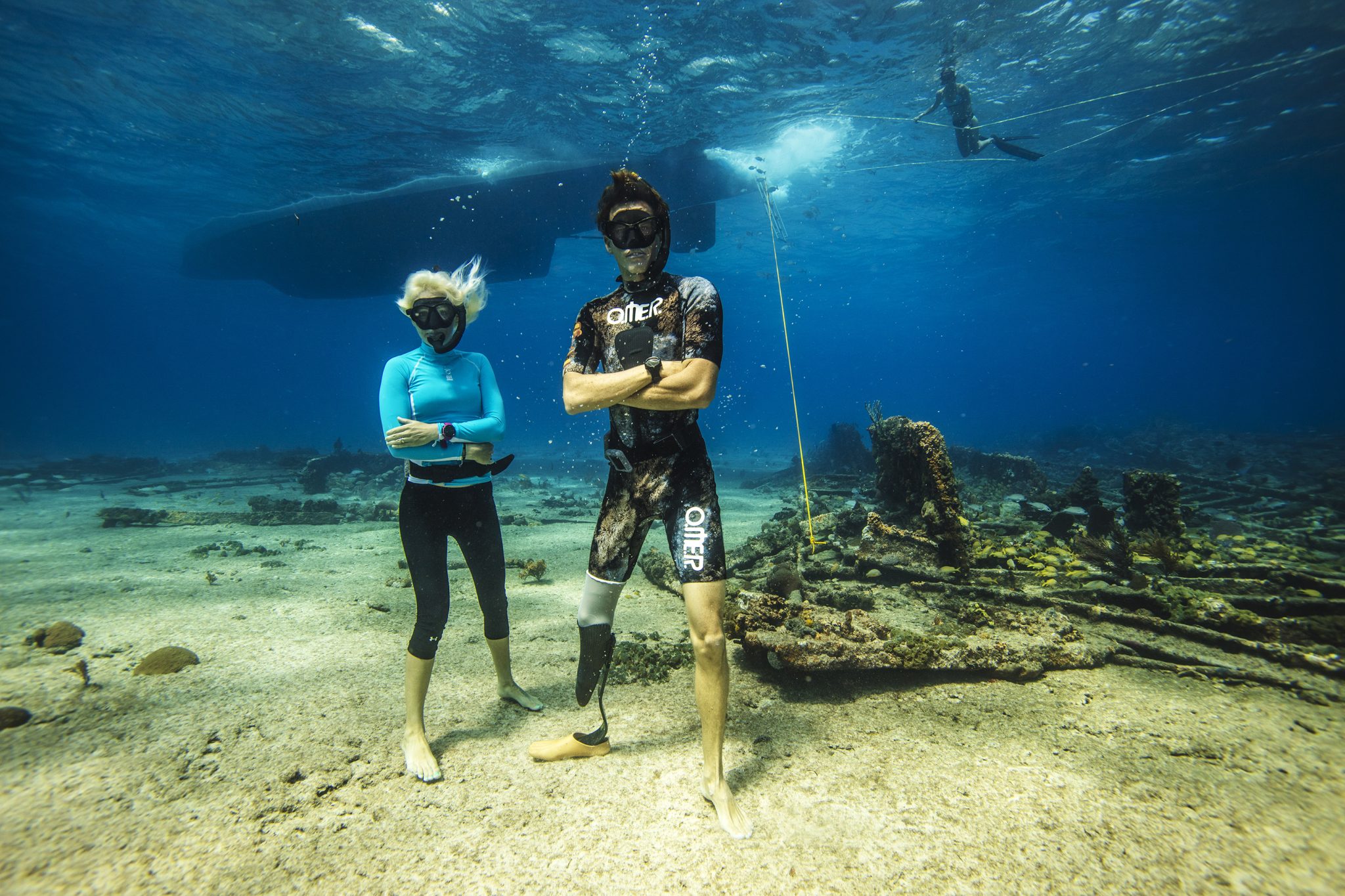Blogs
The healing powers of adaptive diving

PADI highlights how scuba diving helps enrich and heal lives
This International Disabilities Day (3rd December) PADI is reminding the world of the healing aspects that the ocean (or any body of water) can provide and how important it is for helping those with physical or mental challenges improve their wellbeing. From simply being within close proximity of it or diving beneath the salty surface for an underwater adventure, the ocean has the power to heal.
Regardless of your age, ability, or even limitations, the ocean can benefit us physically, emotionally and even spiritually. This is why PADI is on a mission to make those benefits accessible to all, with their Adaptive Techniques Diving Course in the hope that all of humanity can experience the full transformational power of the ocean.
While many are more familiar with traditional therapies, diving, mermaiding or freediving, has changed the lives of those around the world by connecting with the water and enabled them to conquer mental or physical perceived limitations.
The PADI Adaptive Techniques Specialty course is unique in that it’s a pro-level specialty designed to educate and empower PADI Professionals who wish to make scuba and freediver training more accessible.
Through classroom, confined water and open water workshops, dive professionals further cultivate their ability to be student-centered and prescriptive in approach when adapting techniques to meet diver needs. This hands-on training increases awareness of differing abilities and explores adaptive teaching techniques to apply when training divers with physical and mental challenges. PADI Pros learn to adapt course content to accommodate virtually any student diver.
PADI Members Helping those with Disabilities
This International Disabilities Day PADI highlights a shining example of a member who is championing teaching those with disabilities how to dive.
DiveHeart Empowers Individuals Worldwide Through Adaptive Scuba Programmes
DiveHeart, a PADI Dive Centre founded by PADI Scuba Instructor Jim Elliott in 2001, continues to revolutionise the world of adaptive scuba. Using zero gravity and adaptive scuba, DiveHeart aims to instil confidence, foster independence, and elevate self-esteem among individuals facing physical and cognitive challenges.
DiveHeart has established Adaptive Scuba programmes across North America and the Caribbean and reaches global destinations including Malaysia, Australia, China, Israel, and the UK. Through a combination of donations, grants, and strategic partnerships, DiveHeart ensures inclusivity by providing services to children, veterans, individuals with ALS, autism, and others, irrespective of their abilities or financial means.
A significant milestone in DiveHeart’s journey was the hosting of the inaugural Adaptive Scuba Symposium in 2009, held at the prestigious Our World Underwater event in the Midwest. This pioneering symposium attracted a diverse array of experts, including researchers, physicians, professors, therapists, adaptive dive professionals, and participants from across the globe. The event delved into the current state and the future of adaptive scuba, scuba therapy, the adaptive scuba market, the latest in adaptive scuba training techniques and the latest in scuba therapy research.
At the forefront of adaptive scuba initiatives, DiveHeart offers specialised training courses for certified scuba divers to become adaptive dive buddies. Every diver with a disability is paired with two dive buddies to form a cohesive dive team, ensuring a safe and empowering experience.
DiveHeart further hosts regular pool diving programmes catering to divers of all skill levels nationwide and organises immersive week-long adaptive diving trips to ocean locations like Cozumel, Roatán, and others at least three times annually.
Jim Elliot, the Founder and President of DiveHeart, a scuba diving instructor since 1997, recognised the transformative potential of adaptive diving for individuals with physical disabilities. Witnessing firsthand the holistic benefits encompassing physical fitness, emotional well-being, and mental health, Elliot embarked on a mission to make scuba diving accessible and empowering for all.
DiveHeart remains committed to breaking barriers and creating opportunities for individuals facing challenges, enabling them to explore the vast wonders of the underwater world while unlocking their true potential. For more information on DiveHeart and its impactful initiatives, visit www.diveheart.org
People Who Have Healed from Diving
For people with disabilities—whether they use a wheelchair, have a sight impairment or a neurological condition like cerebral palsy—scuba diving can be a fun activity that offers freedom and mobility in the weightlessness of the water. PADI’s Adaptive Support Diver specialty is a course designed to teach friends and family adaptive techniques for diving with a buddy who has a disability. Many students take the course to support a particular person in their life, and the instructor can work with them on the specific skills they require.
Ryan Chen: Diving to Heal the Mind, Body and Spirit
Ryan is a PADI Open Water Scuba Diver who was in a tragic accident as a teenager that left him paralysed. He found healing and clarity through scuba diving with his dive buddy Kent Yoshimura – so much so that during one scuba diving trip he and Kent ended up creating their current company Neuro Gum – a collection of functional gum and mints that help you get energised, calm or focused that has now led him to be named on Forbes 30 under 30.
“Scuba diving was one of the ways I learned that I can do anything, I just have to do it differently,” Chen says, “Scuba diving is one of those things that can change your whole framework. There’s no cooler feeling than taking that first breath underwater. All of a sudden you have this superpower, to breathe underwater and explore.”
Scuba diving continues to be his physical and mental therapy he continually seeks out amidst his busy entrepreneurial life. Now, with Neuro a national success and leading wellness brand in the United States, Chen has kept up his diving, and remained close to PADI as an organisation. Neuro even has a collaboration with PADI’s coral reef restoration project coming up—a special pack of Neuro, with proceeds going to PADI’s non-profit foundation.
Blogs
Alonissos: The complete diving destination (Part 1)

In June we were incredibly fortunate to be invited to dive in Alonissos, a small Greek Island in the Sporades island chain located in the North Aegean Sea. While I have long been a big fan of the Greek Islands as a great holiday destination, I had not had the opportunity to do any diving on previous visits and Mike and I were extremely excited to see what Alonissos had to offer both above and below the surface!

The Sporades are easily accessible via the airport in Skiathos (the first island in the chain), which is served by Jet2 flights from all major UK airports from May through October. Numerous ferries and charter boats make island hopping from Skiathos Town a breeze. After an hour boat ride, the picturesque port of Patitiri was a wonderful introduction to Alonissos, where we were met by our gracious hosts Kostas of Albedo Travel and Dias of Alonissos Triton Dive Center. Mike and I were delighted to be staying at the Paradise Hotel, aptly named for its stunning views over the sea and great location for walking to the waterfront.

Alonissos is beautifully situated in the National Marine Park of Alonissos and the Northern Sporades, the largest marine protected area in Europe. The surrounding seas offer fabulous marine life, including incredibly rare species such as the Mediterranean monk seal. They boast deep walls covered in gorgonians and sponges, stunning topography with caverns, swimthroughs and pinnacles, and the first accessible ancient shipwreck from 500BC!

In locations where historical sites have been reported, the waters are largely restricted, but with collaboration between government, underwater archeologists and dive centres, incredible underwater museums are being created for a truly unique diving experience. Alonissos is home to the first of these, the Ancient Shipwreck of Peristera Accessible Underwater Archeological Site. The chance to dive into history (along with reports of healthy reef life and amazing underwater topography) meant Mike and I were keen to get in the water.

Our introduction to the diving around Alonissos was at the Agios Georgios Pinnacles, in the channel between Alonissos and Skopelos. This fantastic site was named “The Chimney,’ and proved to have a huge amount to see. We got to a decent depth here (over 25m), and marvelled at a colourful reef wall with a wonderful swim through whose rocky walls were absolutely covered with life. As well as brilliant topography there was no shortage of macro life here. We saw numerous nudibranchs, five different species in total. The second dive at Mourtias reef nearby was a shallower dive along a nice wall with lots of crevices. Several moray eels and grouper called this site home. We enjoyed looking in the crevices for lobster and smaller benthic life, such as cup corals and tunicates.

Our itinerary allowed us two dives a day with afternoons left to explore the island with our hire car and evenings to enjoy the famous Greek hospitality. This proved to be a lovely mix of in-water and land based diversions.

The next days diving to the Gorgonian Gardens and Triton’s Cave was to be even better! These two stunning sites are nothing short of fabulous. The Gorgonian Gardens was a deep wall near to the Agios Georgios islands. The ever-present currents in this deep channel meant that the sea life was amazing … the namesake Gorgonian sea fans dotted the wall at a depth of 30 to 50 meters, getting ever larger the deeper we went. Above 30m was by no means less beautiful, with sponges, corals, scorpionfish, moray eels and some rare and colourful nudibranchs.

The second shallower dive of the day was to Triton’s Cave or the Cavern of Skopelos, on the east side of that island. The spectacular rock formations had wild striations both above and below the water making a truly epic topography. The cavern entrance was at 14m, and big enough for a buddy pair, winding up to 6m and passing two beautiful windows out into the blue. Emerging from the cavern, the light at the shallower depths and the incredible rock formations made for a fantastic gentle swimming safety stop and we all surfaced by the boat with massive grins.

Check out our next blog :Alonissos: The complete diving destination (Part 2)” to hear about our amazing dive on the 2500 year old Peristera Wreck!
Thanks to:
Alonissos Triton Dive Center https://bestdivingingreece.com/
Albedo Travel https://alonissosholidays.com/activities/
Paradise Hotel https://paradise-hotel.gr/
Alonissos Municipality https://alonissos.gr/en/
Blogs
Mamma Mia! Diving Skopelos (Part 2)

Our second days dive itinerary was to the famous Christoforos wreck! This is arguably the best dive in Skopelos and though only open to divers with deep diving experience, this 83m long wreck is well worth the visit.
The Christoforos sits in 43 meters of water with the deck at 32 to 35 meters. A 30m dive can give an impressive view of the wreck, though such a large wreck needs a few dives to truly do it justice. Given its ideal location just a 2 minute boat ride from the dive centre dock it is an excellent first dive of the day. The sheltered site is also diveable in all but the absolute worst weather so although deep, the water is usually clear with little to no current making it a very pleasant dive. The site is superb for technical diving and a great training site for the Tec 40 and 45 programs, offered by Skopelos Dive Center.

The Christoforos wreck was originally a collier ship built in 1950 at Grangemouth shipyard under the name “Thomas Hardie”. In 1976 she joined the Greek merchant fleet as “Christoforos”. On the 2nd of October 1983 the Christoforos was carrying 2600 tonnes of cement from Volos to Piraeus Port. During the voyage the weather turned, resulting in the ship developing a 7 degree list, whereby she changed course for safe anchorage at Panormos, Skopelos. The ship reached Panormos at 16:00 with a list of 17 degrees and water ingress to No. 1 hull. Though attempts were made to right the vessel, the crew were ordered to abandon ship at 22:00. The captain, lieutenant and the quartermaster remained to try and save the ship, but had to abandon the attempt themselves and the Christoforos finally sank at 05:30 on 3rd October 1983. She now sits upright in 43 meters of water less than 200m from shore in Panormos.

Diving has only been allowed here since 2018, so the wreck is very well preserved and a real treat to dive. Permission to dive here was granted by the authorities after lots of incredibly hard work by the Skopelos Dive Center staff. Having a fantastic wreck in such an amazing location and in excellent condition is a real privilege.

Of all the sites in Skopelos this was the site Mike and I were most keen to experience. Having kitted up and zipped across the bay to the mooring, we left the surface and followed the descent line until the wreck emerged spectacularly from the blue at 15m. She is a big and beautiful wreck, sitting as though calmly continuing her journey along the seabed. With most of her original features still intact there were points of interest everywhere, including the anchors, winches, ships telegraphs, the wheel and RDF antenna.

We found that aquatic life had colonised the ship, with schools of fish, electric blue nudibranchs, a large moray eel and the resident scorpionfish lurking inside the bridge. The Christoforos was truly a stunning wreck and despite maximising our time at depth we eventually had to say our goodbyes and begin the slow and steady return to the surface.

After a superb morning dive we had the afternoon to do a little sightseeing of the island, with a trip to the church of Agios Ioannis Kastri made famous by the blockbuster movie “Mamma Mia!”. Mike and I spent a happy afternoon pootling around in our little hire car before meeting up with Lina from Skopelos Dive Center. An underwater archeologist as well as a dive professional, Lina had offered to show us a rather special attraction, the Christoforos shipwreck Digital Spot public information and awareness centre.

A fantastic initiative made possible from the collaboration of the government and hard work of the staff at Skopelos Dive Center is the “Digital Spot” in Agnontas port. This information center has a number of displays on the history of the Christoforos wreck, the process by which the wreck was allowed to be opened to the public for diving tourism, other sites of historical interest in the area, a video of the wreck and the best bit, a virtual reality dry dive experience! The beauty of the VR system is that non diving members of the family can see what you have seen on the wreck, or you can see areas that you may not have explored during the dive due to time or depth limitations. It was a truly immersive experience and a great addition to the dive itself.

After a wonderful day we celebrated our last evening on the island with an exquisite meal in Skopelos Town with fabulous views over the town and bay, washed down with the excellent local wine. The lamb with lemon and potatoes was a meal which I could happily eat every day for the rest of my life!

Skopelos is an island that truly has it all. The diving is excellent, the landscape is beautiful with plenty of non diving activities, the locals friendly and the food and drink superb. Given how accessible it is as a holiday destination it has avoided becoming overcrowded and even in peak season offers a fun yet relaxing atmosphere. We highly recommend giving Skopelos a visit. We will certainly be back again!
Thanks to:
Municipality of Skopelos (https://skopelos.com/)
Skopelos Dive Center (https://sporadesdiving.gr/)
Ionia Hotel (https://www.ioniahotel.gr/en)
Dolphin of Skopelos (https://dolphinofskopelos.com/)
Ta Kymata restaurant (@takymata)
The Muses restaurant (https://www.facebook.com/TheMussesMousses/)
Aktaiov resturant (https://skopelos.com/listings/aktaion-taverna/)
-

 Blogs2 months ago
Blogs2 months agoDiving With… Nico, Ocean Earth Travels, Indonesia
-

 News1 month ago
News1 month agoMurex Bangka Announce New Oceanfront Cottages & Beachfront Dining
-

 Blogs2 months ago
Blogs2 months agoA new idea in freediving from RAID
-

 Marine Life & Conservation1 month ago
Marine Life & Conservation1 month agoIceland issue millionaire whale hunter a licence to murder 128 vulnerable fin whales
-

 Marine Life & Conservation2 months ago
Marine Life & Conservation2 months agoThe Shark Trust Great Shark Snapshot is back
-

 News3 months ago
News3 months agoCharting New Waters; NovoScuba Goes Global with the Launch of their Revolutionary Dive Training Agency!
-

 Gear News1 month ago
Gear News1 month agoNew Suunto Ocean – a dive computer and GPS sports watch in one for adventures below and above the surface
-

 Marine Life & Conservation Blogs2 months ago
Marine Life & Conservation Blogs2 months agoBook Review: Plankton


















